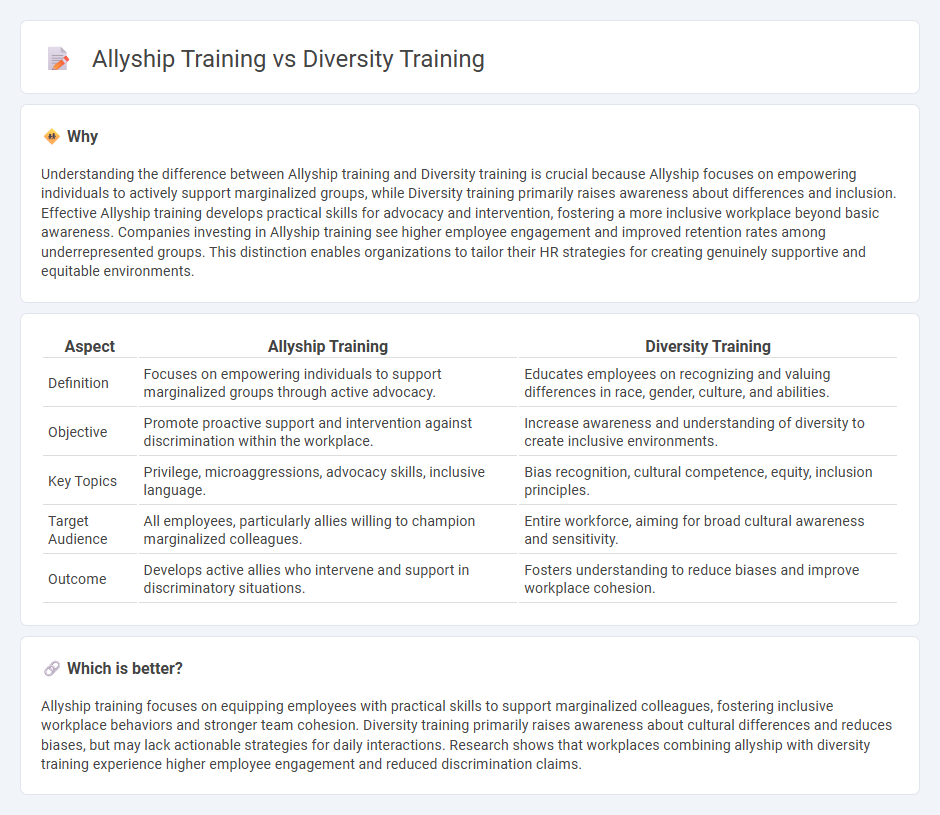
Allyship training focuses on empowering individuals to actively support and advocate for marginalized groups within the workplace, fostering a culture of inclusion and mutual respect. Diversity training aims to increase awareness and understanding of differences in race, gender, culture, and other identities to reduce biases and promote equitable treatment. Explore how combining allyship and diversity training can drive meaningful change in your organization's human resources strategy.
Why it is important
Understanding the difference between Allyship training and Diversity training is crucial because Allyship focuses on empowering individuals to actively support marginalized groups, while Diversity training primarily raises awareness about differences and inclusion. Effective Allyship training develops practical skills for advocacy and intervention, fostering a more inclusive workplace beyond basic awareness. Companies investing in Allyship training see higher employee engagement and improved retention rates among underrepresented groups. This distinction enables organizations to tailor their HR strategies for creating genuinely supportive and equitable environments.
Comparison Table
| Aspect | Allyship Training | Diversity Training |
|---|---|---|
| Definition | Focuses on empowering individuals to support marginalized groups through active advocacy. | Educates employees on recognizing and valuing differences in race, gender, culture, and abilities. |
| Objective | Promote proactive support and intervention against discrimination within the workplace. | Increase awareness and understanding of diversity to create inclusive environments. |
| Key Topics | Privilege, microaggressions, advocacy skills, inclusive language. | Bias recognition, cultural competence, equity, inclusion principles. |
| Target Audience | All employees, particularly allies willing to champion marginalized colleagues. | Entire workforce, aiming for broad cultural awareness and sensitivity. |
| Outcome | Develops active allies who intervene and support in discriminatory situations. | Fosters understanding to reduce biases and improve workplace cohesion. |
Which is better?
Allyship training focuses on equipping employees with practical skills to support marginalized colleagues, fostering inclusive workplace behaviors and stronger team cohesion. Diversity training primarily raises awareness about cultural differences and reduces biases, but may lack actionable strategies for daily interactions. Research shows that workplaces combining allyship with diversity training experience higher employee engagement and reduced discrimination claims.
Connection
Allyship training and Diversity training are interconnected by fostering inclusive workplace cultures through awareness and active support of underrepresented groups. Diversity training provides foundational knowledge on cultural competency and bias reduction, while Allyship training empowers employees to take actionable steps in supporting marginalized colleagues. Together, these programs enhance employee engagement, reduce discrimination, and promote organizational equity.
Key Terms
Diversity training:
Diversity training emphasizes recognizing and valuing differences in race, gender, age, and cultural backgrounds to foster inclusive workplaces. This type of training equips employees with awareness and skills to reduce biases and discrimination, promoting equitable interactions and decision-making. Explore more to understand how diversity training can transform organizational culture and drive business success.
Unconscious Bias
Diversity training primarily targets the identification and mitigation of unconscious bias to create inclusive workplaces, emphasizing awareness and behavioral change. Allyship training builds on this foundation by equipping individuals with active strategies to support marginalized groups and advocate for systemic equity beyond personal bias recognition. Explore these training approaches in detail to enhance organizational culture and develop effective inclusion practices.
Cultural Competence
Diversity training primarily emphasizes understanding and respecting cultural differences to enhance workplace inclusivity, whereas allyship training focuses on actively supporting marginalized groups through advocacy and informed actions. Cultural competence is developed in diversity training by increasing awareness of various cultural norms and biases, while allyship training fosters skills to intervene and challenge discrimination effectively. Explore more about how these training types build cultural competence and promote equity in organizations.
Source and External Links
5 Types of Diversity Training in the Workplace - This article discusses the components and importance of diversity training in enhancing workplace inclusivity.
Diversity Training in the Workplace - Offers strategies for facilitating intercultural relationships and creating a positive diversity climate in organizations.
Top 10 Free Diversity Training Programs - Highlights ten free diversity training programs to reduce discrimination and promote equality in the workplace.
 dowidth.com
dowidth.com